Chapter 10
Getting Found Through Search Engine Optimization
In This Chapter
![]() Understanding the major search engines
Understanding the major search engines
![]() Learning about Google’s algorithm and what it means for SEO
Learning about Google’s algorithm and what it means for SEO
![]() Working with keywords to improve your chances of getting found
Working with keywords to improve your chances of getting found
![]() Optimizing your site with on-page SEO and link-building techniques
Optimizing your site with on-page SEO and link-building techniques
According to Mashable, more than 1.1 billion people use Google search each month, making 114 billion searches. Pretty incredible, right? It's pretty much guaranteed that your potential leads are conducting millions of searches each month using keywords that describe what you are selling exactly, or the problem you help solve. And if you aren’t optimizing your website for search, you are not getting found.
Picture this: You are the sales director of a business looking for customer relationship management (CRM) software. So you search Google for B2B CRM software. The sites that are most optimized for search appear in the first couple of pages of results. Most likely, you are going to click the results that appear on the first page. In fact, a recent study done by the company Chitika reports that the top listing in Google’s organic search results receives 33 percent of the traffic, compared to 18 percent for the second position. And that’s just talking about the first and second results! Imagine if you appear on the second or even third page? The farther down in the search results you appear, the less likely it is that leads are going to find your company.
In order to appear on the first page of Google so that leads can find your company immediately, your website needs strong search engine optimization (SEO). Not all companies garner immediate name recognition, and even those that do still use SEO methods to introduce themselves to new audiences. In order to get that brand awareness, you need to get in front of people. Search Engine Land, a news source for everything SEO, defines SEO as “the process of getting traffic from the ‘free’ or ‘natural’ listings on search engines. These listings are ranked based on what the search engine considers most relevant to the users. Payment isn’t involved, as it is with paid search ads.”
Maximizing Different Traffic Sources
SEO is an important part of lead generation because it makes your site more visible to potential leads. Without good SEO, you risk never being found. You can conduct as many inbound and outbound programs as you want, but if you don’t have SEO, you are missing out on leads who are searching for target keyword phrases that describe your business and could lead them to your website. And it is safe to say that if a lead is searching for target keywords that describe what you are offering, she is probably farther along in the buying cycle than someone who happened upon an ebook through Twitter.
To understand how the search engines function, it is critical to understand the types of search options available to businesses.
Discovering site visitors with organic search
Organic search is the bread and butter of SEO and is really what you will be focusing on optimizing. Organic search results refer to the lists of websites that Google spits out after you type a keyword into its search bar.
Every website is crawled (or analyzed) by Google so that Google can determine what a site does and how relevant it is to a given keyword. It makes assertions about what a site does based on patterns of words and phrases within the site. (That is why keywords are so key!) Google’s main crawler is called Googlebot, and it crawls the entire web indexing (also known as organizing) new sites based on guidance from a sophisticated algorithm (also known as a top-secret formula) that identifies which sites to crawl, how often to do it, and how many pages to index from each site.
Google and other search engines use many factors to determine where a site ranks for each keyword, and I'll go into more detail on specific strategy throughout this chapter. For now, the important distinction to make is that the organic search results that are influenced by good SEO are those that come up on the first page of results and are not marked with an Ad Related To label. See Figure 10-1 for an example.
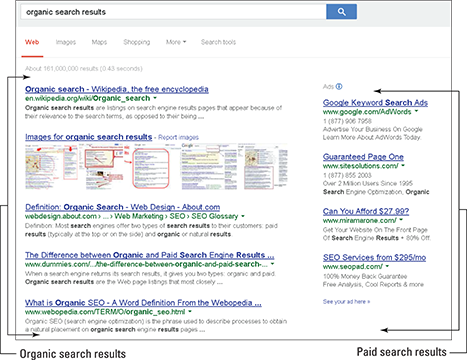
Figure 10-1: Organic search results.
Attracting site visitors with paid search
I will go into much more detail about paid search later in Chapter 11; however, it's important to introduce the concept here because I want you to know the distinction between paid and organic results. Paid results are ads appearing on the very top and the right side of a search results page. Paid ads are purchased through the search engine on a cost-per-click (CPC) model. That means the buyer pays only for the number of times the link for that ad is clicked. For paid ads, you determine keywords, copy, and CTAs (calls to action) to use. In contrast to paid search results, money can't buy you good organic results — instead, you need to understand how to optimize your site properly.
Knowing Your Search Engines
There are three major search engines to consider: Google, Bing, and Yahoo!. Although Google clearly has the lion’s share of search usage — 66.7 percent according to comScore — you do want to keep the other search engines in mind too. People have their favorites, and you certainly don’t want to alienate those using Bing or Yahoo!.
For the most part, many of the techniques you apply to being optimized for Google apply to the other search engines as well, but there are a few things to keep in mind about each.
Grasping Google
Google is the search giant. With 66.7 percent of search traffic, it's safe to say that Google is the one you should be optimizing for. And Google is very tough to optimize for because all your competitors also know that Google is the 900-pound gorilla and are also vying for prominent listings on Google’s search results. Google uses a top-secret and complex formula to determine what your website is and where it should rank, and this formula (or algorithm) changes constantly. You need to be up on the trends for how each algorithm change can affect your optimization.
Google also has a variety of tools to help you further optimize and analyze your site including Google Insights, Google Trends, Google Zeitgeist, and Google AdWords.
In addition to web search, Google has image search, news search, shopping, maps, news, videos, blogs, discussions, and more so users can customize and filter their search results.
Figure 10-2 shows an example of the first page of Google results when I search for the term lead generation, so you get an idea of Google’s layout.
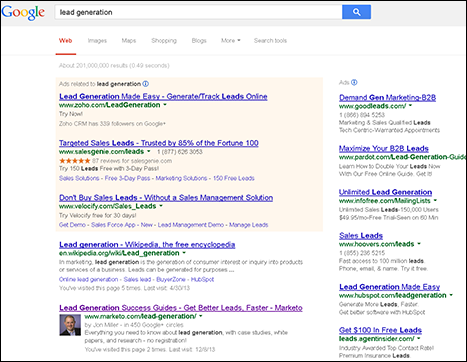
Figure 10-2: Google search results.
Embracing Bing
Bing is Microsoft’s search engine. Bing is a fairly new search engine and gets approximately 18 percent of search traffic. It's by no means catching up to Google’s 66.7 percent, but it's still notable and worth spending some effort on. Bing also has its own algorithm for determining a page’s rank compared to similar pages found elsewhere on the web. Because Bing is a much younger search engine, it's still trying to work out some of the kinks.
Bing does not have some of the rich indexing capabilities that Google has today. According to Search Discovery. an interactive marketing agency, Bing hasn’t yet achieved the same sort of eye towards content, authenticity, and social signals as Google currently has.
Figure 10-3 shows an example of Bing’s first page of results for lead generation. Notice the differences between the top page result here versus that in Figure 10-2. Also notice the addition of Related Searches and Social Results on the right side.
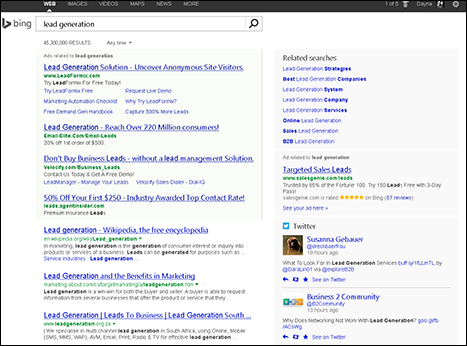
Figure 10-3: Bing search results.
In 2009, Bing and Yahoo! signed a ten-year partnership for Bing’s search engine technology to be leased to Yahoo! to provide search results from Yahoo!’s websites. Microsoft had incentive to do so to broaden its coverage against its main competitor, Google, but the jury is still out on the results.
Looking at Yahoo!
Yahoo!'s percentage of search share has dropped to 11.4 percent and continues to drop, presumably due to brand inconsistencies and an older search model. However, as with Bing, you don’t want to lose out on those 11.4 percent of leads who are die-hard Yahoo! fans. They search for things while using any of Yahoo!’s sites that provide loyal customers with free email, stock information, fantasy sports leagues, instant messaging, and even weather information.
Like Bing, Yahoo!’s search engine simply isn't as sophisticated as Google’s, and instead focuses on traditional SEO ranking factors that fail to recognize the importance of a multichannel world where social media and various devices reign supreme.
In 2009, Yahoo! agreed to lease Bing’s search technology under the hood to power search results for their sites. One of the reasons, at the time, was to allow Yahoo! to focus on providing improved visitor experiences on its various website properties. Only time will tell how the effort and recent alliance with Microsoft will affect rankings.
Figure 10-4 shows the results page of the same search term lead generation on Yahoo!. Again, notice the differences in layout and the results. Ads appear to the top left and to the right.
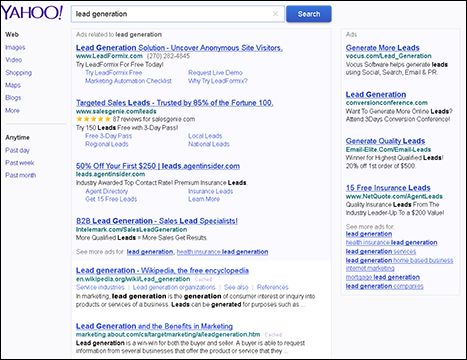
Figure 10-4: Yahoo! search results.
Making the Most out of Google Algorithm Updates
Although Bing and Yahoo! should not be ignored, I'm going to focus mostly on Google for the rest of this chapter, especially because most of your search traffic leads will be coming from Google.
Understanding Hummingbird
When I first started on the outline for this book, Google had released Penguin 2.0. (Google gives each of its algorithm releases code names.) However, because Google changes their algorithm so frequently, they are now onto Hummingbird — which is an entirely new algorithm and a major overhaul. By the time you’re reading this, they will most likely be onto yet another code name. According to Google search chief Amit Sighal, the last time the algorithm was updated so dramatically was in 2001. So Hummingbird is a big deal and worth spending a bit of time on, even if by the time this book comes out they're onto Hummingbird 2.0 or an entirely new code name.
The biggest change that Google announced with Hummingbird is its ability to decipher conversational search phrases. That means the algorithm can focus on the meaning behind what you are asking, versus only focusing on a string of keywords to give relevant results to the search engine user. Search Engine Land states that “Hummingbird is paying more attention to each word in a query, ensuring the whole query — the whole sentence or conversation or meaning — is taken into account, rather than just particular keywords. The goal is that pages matching meaning and intent do better than pages matching only a few words.”
This is a very critical advance in search engine technology because Google is interpreting relevance and actual meaning. The upside for searchers like you and me is that Google will be returning results that make more sense in the context of their search.
But how do you optimize for relevance in Google’s algorithms? Read on for more info.
Avoiding over-optimization
In the past, SEO was easy (well, kind of). You chose a few keywords and created pages and pages of copy with keywords stuffed in. This resulted in a website page that sounded unnatural and often contained crappy content. However, the more keywords you were able to stuff in to a website or page, the greater probability that you’d appear higher up in the search results. Figure 10-5 shows an example of what I mean by keyword stuffing. Notice the unnatural placement of the keyword.
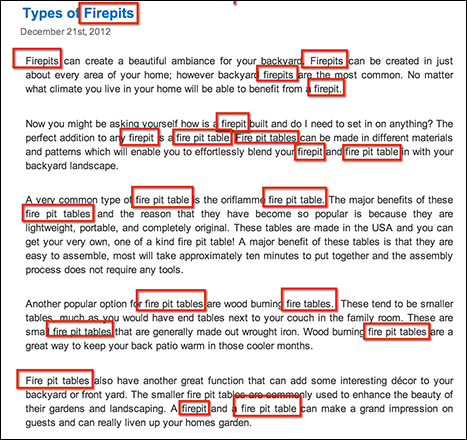
Figure 10-5: Keyword stuffing.
Over the years, Google figured out that keyword stuffing and over-optimization did not necessarily mean the best results for their audience of searchers. In fact, many times, a user clicked the first search result, only to be brought to a page filled with keywords without any real relevance to their initial query.
As the web has become more and more complex, search engines have followed suit, and Google now realizes that keywords alone mean nothing to relevant search results. Instead, quality content is what should be awarded higher placement in results. So yes, keywords are important and I'll talk about them at length, but keyword stuffing is a big no-no and can in fact downgrade you in search results.
Getting quality link-backs
Another key to a relevant and helpful website is quality link-backs from other well-regarded sites that also rank high on Google search results. Google believes that if other good websites are linking back to you, your site must also have something worth talking about, and thus, one that people would be interested in discovering.
Quality link-backs are typically given to destination pages such as a blog or other high-quality content because external websites want to focus on linking to interesting content, not keyword-stuffed pages.
Leveraging authentic content
Google and other search engines are heavily weighing content as a determining factor in where the website should rank. If a site is offering educational content to its visitors, it most likely has information that a searcher would find helpful. If a site has nonsensical information due to keyword stuffing or content that is way too basic for any searcher with common sense, the visitor leaves that website, and the search engine that provided this irrelevant site loses some credibility in this person’s eyes. This could lead to searches being conducted on a different website, which means fewer eyeballs on the original search engine site, which means that website eventually has to lower the price it charges for people to advertise on their site. (Those costs-per-click will go down.)
Google is looking at authentic content on all of your pages including your home page, product pages, your blog, content resource center, and any other place on your site that has copy.
Connecting social media
Another indicator of a high-quality website is social signals — how often are people engaging with you on social channels such as Twitter, Facebook, and Google+? Google’s algorithm looks at the following when determining rankings based on social signals:
- Engagement on social channels such as your content being shared
- Mentions on social channels
- Linked content such as the
rel="author"tag for Google+ (see Chapter 9 for more information on this and how to set it up) - Backlinks from content-sharing sites like Pinterest
Choosing Your Keywords
The first step to creating your SEO strategy (after learning the search engine optimization basics and looking up Google’s latest and greatest update), is to choose your keywords. Ask yourself what you want to rank for. This can be answered after asking yourself and your team a series of simple questions:
- What does my company do?
- What is the key search term(s) people use when they want to learn more about my business?
- What are my different product/service lines?
- What needs do my product/service fill?
- What are the features of my product/service lines?
- What keywords do my competitors rank for?
- Where am I ranking now for these keywords?
- What is the traffic opportunity for each keyword? (Read the Tip in the following section to discover how you can easily find out.)
Building a better keyword list
After you have the answers to the preceding questions, you can start thinking about what keywords make sense and then create a strategy to optimize for your chosen terms. Note that you won’t have a fully baked and executed strategy overnight, so plan on instituting a step-by-step approach to optimization. Start with your top keywords, and then go from there.
Initially, a great way to keep track of your keywords and priorities is to create a spreadsheet that lists each keyword, keyword phrase, its priority, and the page URL you want your keyword to link to, which should be the page that you want to rank for. To determine keyword priority, think about the keywords that map closest to your core competencies as a business. For instance, if you own a hair salon, your top priority keywords might be salon, hair, hair salon, beauty, hair styling, and so on. And then, you might choose keywords like waxing, coloring, makeup application, and so on, for the next level of priority.
Optimizing for keywords
There are many ways to optimize for keywords throughout your site. After you choose and rank your top keywords and determine which page you want to rank for each term, you need to make sure each page is optimized — meaning you are making it easy for a search engine to know exactly what your page is talking about.
Of course, the first step to keyword optimization is through on-page SEO and good content, which I talk about more in depth in the next section. However, there are a couple of additional techniques you can use to make sure each page is optimized correctly for each keyword:
- Headline: Your headline on a web page should always match your keyword page titles. If a visitor clicks your page title in the search engine results, she expects a certain outcome. It is critical for user experience and keyword consistency to make sure your headline (H1, in HTML-speak) delivers the right message. Note that your H1 doesn’t have to match your title exactly, but it should be similar enough that your visitor isn’t confused. For instance, if I search for marketing automation on Google, I expect to go to a page that has a headline about marketing automation, such as “Marketing Automation Success Center." If I go to a page that says “lead nurturing software,” I might be a tad confused.
- Images: Using images on your page can help your SEO rankings. Also note that your image can come up on Google image search, so you want to make sure all of your images are optimized. Moz, a popular SEO blog and consultancy, suggests that your image have a title, a filename that contains keywords (as opposed to unrecognizable abbreviations), and
altattributes (alternative text that is rendered when an image can’t be seen, for instance, if someone views your page on a phone. The alt text tells a viewer what he should be looking at) as a good SEO practice. Each of these elements can be added via your website content management system (CMS).
Creating power content
Instead of keyword-stuffed content, create what’s called power content for optimization. Power content is educational, informative, credible, and uses natural keyword placement for emphasis. To rank for certain words on certain pages, create power content to optimize your web site pages to be premiere educational resources on each subject. You want people to come to your site not only to view your content resources, but you also want to create a main page that people view as the definitive page on your keyword.
For example, Marketo wanted to rank for the keyword phrase marketing automation and chose their resource page, where all their content was housed, as the primary page URL they wanted to drive traffic to. They added power content to the page to help it rank.
Figure 10-6 shows an example of power content. Note that it reads naturally and answers many questions a visitor might have on the subject of marketing automation.
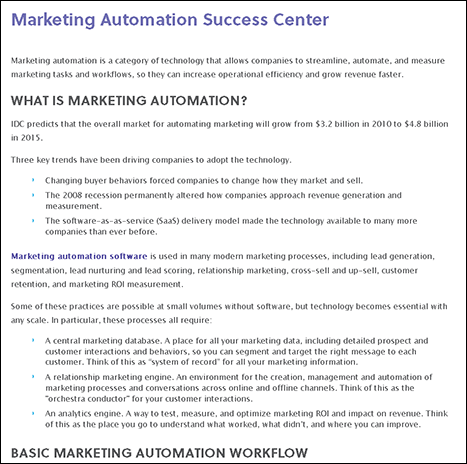
Figure 10-6: Marketing automation power content.
Nate Dame from SEOperks believes your power copy should include the following elements:
- Describe your keyword — what is it?
- Why is it important? How will this page help you?
- Three to five types, options, or topics related to your keyword
- Data and statistics (if available)
- One or two experts on a topic and a quote
- Why your company should be selected
- Conclusion
- A strong CTA
- External resources and further reading
Perfecting On-Page SEO
On-page SEO applies to the techniques you can use to make a certain page rank for a keyword. Remember that you want to assign one page to one keyword, so on-page SEO is very important — Google needs to know what should rank for what keyword.
The most important factor of on-page SEO is ultimately the content. At the risk of sounding repetitive here, great content drives relevancy, which aids greatly in boosting your website to the top of the search results. According to Moz, your content must have the following attributes:
- It must supply a demand: Great SEO on-page content fills a need. The highest ranking goes to the page that answers that need most specifically. Good content can be web copy, video, images, or sound.
- It must be linkable: People need to link to your content. If people don’t link to your content, the search engines won't rank it high.
To set the stage, Figure 10-7 shows a skeleton layout of a perfectly optimized page for the keyword term chocolate donuts.
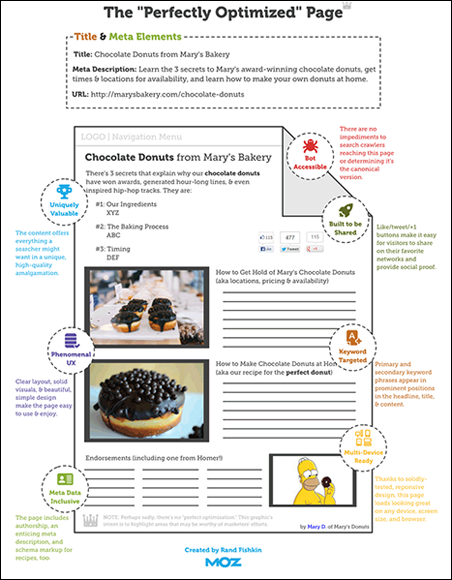
Figure 10-7: An optimized page.
Assigning title tags
After you have created content that is both linkable and in demand, you need to think about your title tags. A title tag describes a document or page. It appears in browsers, search engine result pages, and external websites. Your title tags should always align with a keyword term you have deemed important.
Figure 10-8 and Figure 10-9 show examples of title tags in each key location.
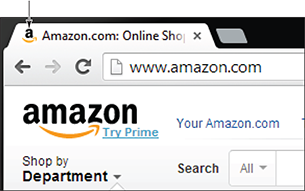
Figure 10-8: A title tag in a browser.
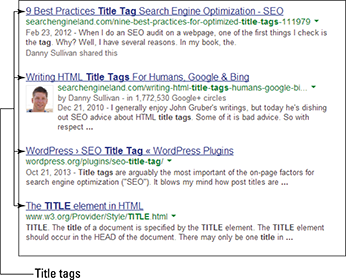
Figure 10-9: A title tag in a search engine result page.
The key to success with title tags is to accurately describe the content on each page. If your title tag is not relevant, viewers will bounce and the user experience will be hindered.
Here are some best practices from Moz to ensure your title tag is relevant to your visitors:
- Watch your length. Try to have titles fewer than 70 characters. If they're longer, search engines will cut off your headline.
- Place important keywords close to the beginning of your title tag.
- Assess how well-known your brand is — if it is well-known, include it in your title tag because it may induce more clicks.
- Create a compelling and interesting title tag.
Structuring your URLs
Your URL is what appears in the browser bar at the top of your page when visitors navigate to your site. Your URL should be concise and include keywords. You also want to structure your URLs to mimic your site’s page structure in order to show a clear hierarchy. Search engines use this to determine how items relate to one another on your page and in the overall context of your keywords.
Figure 10-10 shows an example URL.

Figure 10-10: A URL with a clear hierarchy.
Note the hierarchy here. We know that Press Releases are in the News section, which is in the About primary navigation. It is logical, obvious, and I know exactly what the page is from looking at the URL.
Wording your meta description
Meta keywords may be a thing of the past, but you do need to focus on creating a good meta description for your page. A meta description is what the search engine pulls as the description to your page for search engine results, as seen in Figure 10-11.

Figure 10-11: A meta description in search results.
This is your chance to up the ante and entice more leads to click. Think of your meta description as an online ad or even a tweet. Note that meta descriptions are only 160 characters, so you need to keep them short, sweet, and interesting. For optimal lead generation, think about including a strong CTA so you can ask for the click.
Utilizing Links in a Natural Way
Establishing authority on one (or all) of the major search engines requires a strong mix of on-page SEO and link-building efforts. Your content is only good if people actually link to it — this is what the search engines are paying attention to. Google determines authority through great content and a strong link-building profile.
Link building is the practice of adding links to your site and getting sites that rank high on Google to link to your content. When measuring link value, Google tends to look at the following factors:
- Overall popularity of the site — both globally and locally
- Having the right keywords in the anchor text
- Having a trusted domain
- Analysis of other links on the linking site
- Social signals from the linking site
Starting with on-page links
On-page links send a signal to Google that you have chosen a primary page to rank for each keyword. In order to do this, you need to build links throughout your site by linking the intended keyword to the intended page.
Figure 10-12 shows an example for the term email marketing. Marketo wants their email marketing resource page to rank for that term, so all of the link building they do externally reflects this.
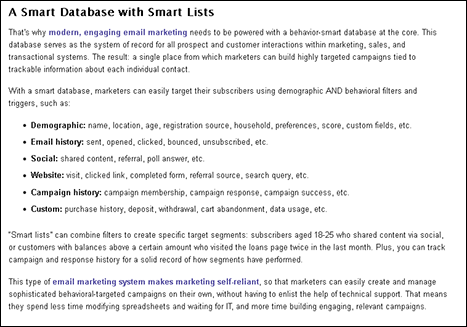
Figure 10-12: Natural on-page link building.
Any post about email marketing on their blog is linked to this page. Note that you want to make sure your language is natural. Remember the “no keyword stuffing” rule? The same is true when you are dealing with link building. Use natural language. No stuffing.
Leveraging influencer relationships
In addition to on-page links that you create yourself, you also need other sites linking to your page. This can be done naturally by producing good-quality linkable content, but you also want to do some influencer outreach to get other sites with high domain authority to link to your page. Influencers in your space can be people and sites with high trust and authority, press and media outlets, sites with lots of social followers, or other influential people that you want to or currently do business with.
If you include influencer quotes and links on your own pages, they often link back to you. Reach out to influential people for each topic, ask for a quote, provide a link for them, and ask for a link back. Most influencers will be more than willing to help you, especially if you provide a link back to their site as well. Take a look at an example in Figure 10-13 of influencer quoting in event marketing power copy.
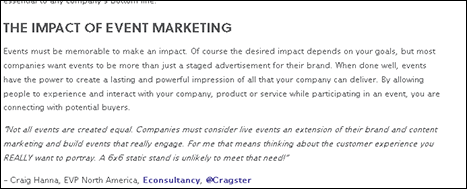
Figure 10-13: An influencer quote in power copy.
If you maintain these relationships, you can reach out to them from time to time to ask for favors or links. Influencer marketing is hard and probably should be a For Dummies book all its own, but it's an important concept when it comes to SEO for lead generation. If the influential people in your space trust and value your content, Google will rank it highly, and you can also build trust with your leads because your site is being linked to from influential sources that they trust.
Defining Your SEO Measurements and Analytics
To determine how successful your SEO strategy is at attracting leads and increasing your position in Google’s rankings, you need a solid set of metrics. But first, you need to make sure you are benchmarking by measuring where you rank when you begin your SEO efforts so you know how far you have come:
- Search engine ranking: For each keyword, determine where you are ranking now, and make sure you keep track of rank as you increase the level of your SEO strategy over time. Note when you dip, and note when you climb. You should keep tabs on activity for all of the three major search engines.
- Referring visits: This is a log of all the traffic sources to your site. You want to look at direct navigation (when someone types in your URL directly), referral traffic (traffic coming from links on another website), and search traffic (traffic coming from any of the three major search engines).
- Keyword phrase traffic: Which keywords are sending traffic to your site? Are your efforts surrounding your top keywords bringing in more traffic? Or do you need to do something different? Also see what keywords you might not be targeting that bring in heavy traffic.
- Conversion rates: In the spirit of lead generation, you want to figure out who is converting from which keywords. You might need an SEO-specific tool to figure out this data, but ultimately you need to determine which keywords are converting and which aren’t out of all of the traffic coming to your site from a search engine. That data can help you to determine where you should be spending your time.
- Specific page traffic: Which of your pages is getting the most traffic from search engines? And are these pages the right pages? You can also look at indexing by seeing whether Google is indexing your pages properly by doing a simple search to see where and how your page shows up. And if Google isn’t, you need to work on determining why.
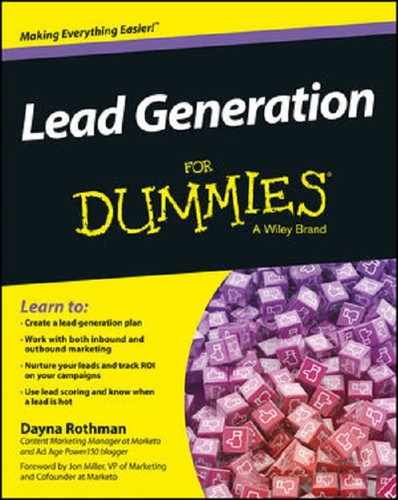
 Just optimizing your website for search will not guarantee you a page one listing on a search engine. If only life were that easy! Remember that your competition is also vying for this position, and chances are they also know about SEO. Search engines factor in multiple criteria to return websites that they feel are the most useful to their users. Excellent SEO is just one piece of the puzzle. Make sure you also offer a quality product and a good browsing experience for your website visitors.
Just optimizing your website for search will not guarantee you a page one listing on a search engine. If only life were that easy! Remember that your competition is also vying for this position, and chances are they also know about SEO. Search engines factor in multiple criteria to return websites that they feel are the most useful to their users. Excellent SEO is just one piece of the puzzle. Make sure you also offer a quality product and a good browsing experience for your website visitors. An important thing to note is that in order to be optimized for Google, you need to really keep up with the trends. That means knowing about Google’s most recent algorithm updates and what that means for your SEO strategy. Google updates frequently, and sometimes an update can really change how you think about your search engine optimization. Some great resources to find the latest news about SEO are
An important thing to note is that in order to be optimized for Google, you need to really keep up with the trends. That means knowing about Google’s most recent algorithm updates and what that means for your SEO strategy. Google updates frequently, and sometimes an update can really change how you think about your search engine optimization. Some great resources to find the latest news about SEO are  Google is telling users that it will penalize the use of sneaky, keyword-stuffed tactics like hidden text, so be careful of using some of these old SEO tactics. You won’t necessarily get a warning email from Google if you’re guilty of these things. You’ll get the message loud and clear, however, when your search engine ranking drops like a brick.
Google is telling users that it will penalize the use of sneaky, keyword-stuffed tactics like hidden text, so be careful of using some of these old SEO tactics. You won’t necessarily get a warning email from Google if you’re guilty of these things. You’ll get the message loud and clear, however, when your search engine ranking drops like a brick.